Brigitte Helm was a German actress, best remembered for her dual role as Maria and her double named Futura, in Fritz Lang's 1927 silent film, Metropolis.
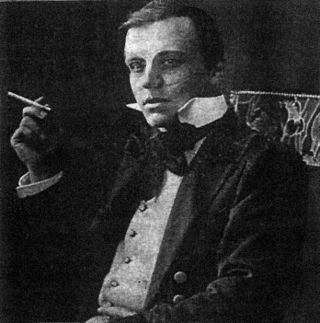
Hanns Heinz Ewers was a German actor, poet, philosopher, and writer of short stories and novels. While he wrote on a wide range of subjects, he is now known mainly for his works of horror, particularly his trilogy of novels about the adventures of Frank Braun, a character modeled on himself. The best known of these is Alraune (1911).

Alraune is a novel by German novelist Hanns Heinz Ewers published in 1911. It is also the name of the female lead character. The book originally featured illustrations by Ilna Ewers-Wunderwald.
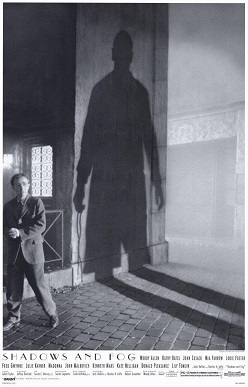
Shadows and Fog is a 1991 American black-and-white comedy film directed by Woody Allen and based on his one-act play Death (1975). It stars Allen, Mia Farrow, John Malkovich, Kathy Bates, David Ogden Stiers, Jodie Foster, Lily Tomlin, John Cusack, Madonna, and Kenneth Mars. It was filmed on a 26,000-square-foot (2,400 m2) set at Kaufman Astoria Studios, which was the biggest set ever built in New York. It was also Allen's last film for Orion Pictures.
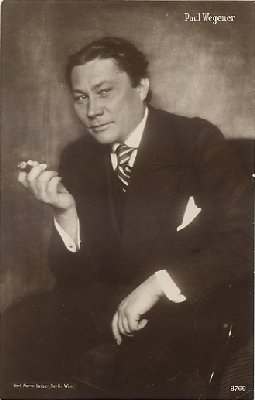
Paul Wegener was a German actor, writer, and film director known for his pioneering role in German expressionist cinema.
Der Golem is a partially lost 1915 German silent horror film written and directed by Paul Wegener and Henrik Galeen. It was inspired by a Jewish folktale, the most prevalent version of the story involving 16th century Rabbi Judah Loew ben Bezalel who created the Golem to protect his people from antisemites. Wegener claimed the film was based on Gustav Meyrink's 1915 novel The Golem, but, as the movie has little to do with existing Jewish traditions, Troy Howarth states "it is more likely that simply drew upon European folklore".

Iván Petrovich was a Serbian film actor and singer.

Alraune is a 1918 Hungarian science fiction horror film directed by Michael Curtiz and Edmund Fritz. It starred Géza Erdélyi. Little is known about this film and it is believed to be lost. Alraune is German for mandrake. The film is based on the novel Alraune by German novelist Hanns Heinz Ewers that was published in 1911.

Alraune is a German science fiction horror film directed by Richard Oswald. Like the 1928 version, this movie again features Brigitte Helm in the role of Alraune. This version aimed for greater realism but is still based upon the original German myth.

Alraune, later renamed Unnatural: The Fruit of Evil, is a 1952 black and white West German science fiction film directed by Arthur Maria Rabenalt, based on the 1911 novel Alraune by German novelist Hanns Heinz Ewers, starring Hildegard Knef and Erich von Stroheim. The film involves a scientist who creates a woman (Knef) who is beautiful and yet soulless, lacking any sense of morality.
Die Försterchristl is an operetta in three acts by Georg Jarno to a libretto by Bernhard Buchbinder. It premiered on 17 December 1907 at the Theater in der Josefstadt in Vienna. Three years later, its English version by librettist Leonard Liebling had a run of 64 performances at Broadway's Herald Square Theatre in 1910/11 under the title The Girl and the Kaiser. The work is known in English as The Girl and the Kaiser, The Bohemian Dancer, The Forester's Daughter and in French as La petite amie de sa majesté and Christelle et l'empereur.
Alraune is a fictional female character in a novel of the same name by German writer Hanns Heinz Ewers.
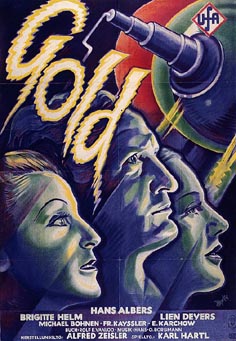
Gold is a 1934 German science fiction film directed by Karl Hartl. The film involves a British scientist who is attempting to create a device that turns base materials into gold. He later forces the German scientist's assistant Werner Holk, who was working on a similar experiment, to come to his underwater nuclear reactor to help him. Gold was made in both German-language and French-language versions with Brigitte Helm reprising her role in both.
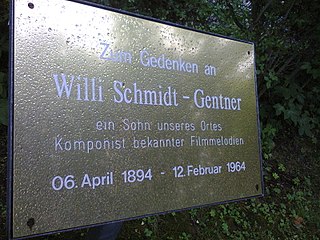
Willy Schmidt-Gentner was one of the most successful German composers of film music in the history of German-language cinema. He moved to Vienna in 1933. At his most productive, he scored up to 10 films a year, including numerous classics and masterpieces of the German and Austrian cinema.

Valeska Gert was a German dancer, pantomime, cabaret artist, actress and pioneering performance artist.
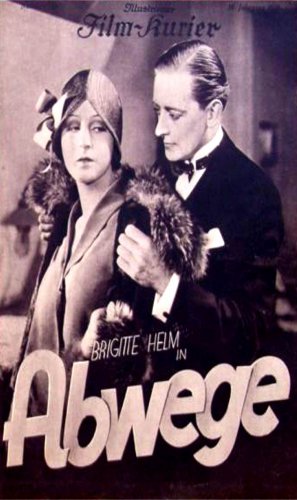
The Devious Path, also titled Crisis, is a 1928 German silent drama film directed by Georg Wilhelm Pabst starring Gustav Diessl and Brigitte Helm.

"Up in the Gallery" is a short piece of fiction written by Franz Kafka. It was created between November 1916 and February 1917 and published in the collection Ein Landarzt in 1919. The story offers two versions of a scene in which a young man watches a circus ringmaster and a woman on horseback.

Paul Hörbiger was an Austrian theatre and film actor.
Henrik Galeen was an Austrian-born actor, screenwriter and film director considered an influential figure in the development of German Expressionist cinema during the silent era.

The Singing City is a 1930 German musical film directed by Carmine Gallone and starring Jan Kiepura, Brigitte Helm and Walter Janssen.















